| Columns Retired Columns & Blogs |
Too costly for buying on a whim, but right in there for when it will be time for real shopping.
Michael Fremer was impressed by the Paradox Phono 70 Signature phono preamplifier when he reviewed it in his March 2022 Analog Corner column (footnote 1). "If you want a neutral player that's quiet, super–well-organized, and can plumb the depths and scale the peaks without adding colorations, the Phono 70 Signature is well worth considering," he concluded. Mikey suggested it would be worth my taking a look at its measured performance, so I performed a complete set of measurements with my Audio Precision SYS2722 system.
The Phono 70 Signature is intended to be used with low-output moving coil cartridges and is powered by an outboard DC power supply. The display on the supply indicated that the output voltage was 18.3V, close to the specified 18V. The unloaded input impedance is specified as 100k ohms—I measured 90k ohms at low and middle frequencies, dropping inconsequentially to 55k ohms at the top of the audioband. This is too high to properly load moving coil cartridges, so the Phono 70 Signature uses a second pair of RCA jacks next to the input RCAs, into which RCA plugs with a resistor connected to screwdown terminals are inserted. I connected a resistor with a nominal value of 470 ohms to the RCA plug's terminals and remeasured the input impedance. It was now 468 ohms at 20Hz and 1kHz, 511 ohms at 20kHz.
The Phono 70 Signature inverted polarity. Its output impedance is specified as 3.3k ohms. I measured 2.6k ohms at 20Hz and 1kHz, rising to 8.3k ohms at 20kHz. The Phono 70 should be used with a line preamplifier having an input impedance of at least 20k ohms if the low frequencies are not to sound lightweight. (Mikey's darTZeel NHB-18NS preamplifier has an unbalanced input impedance of 22k ohms at 20Hz.)
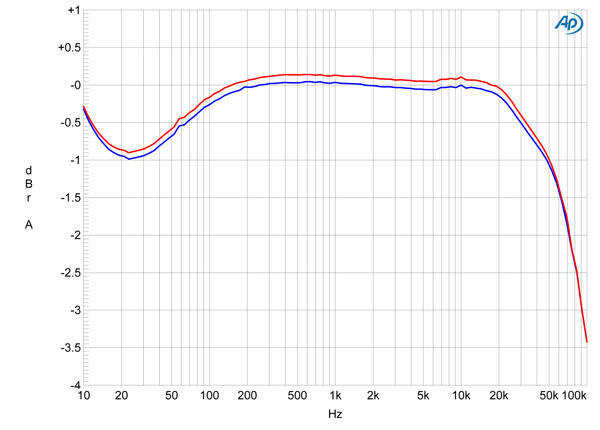
The specified gain is 70dB. I measured 66.1dB at 1kHz, which is still appropriate for a low-output moving coil cartridge. Fig.1 shows the preamp's frequency response. The error in the RIAA deemphasis is superbly low from 100Hz to 20kHz, with excellent channel matching, though there is a 1dB drop in output in the low bass, centered on 23Hz. Although designer Terence Robinson had told MF that the Paradox Phono 70 Signature's RIAA correction included the so-called Neumann fourth-pole time constant of 3.18µs, the ultrasonic outputs rolls off smoothly above 20kHz, reaching –3dB at 90kHz, rather than rising above 50kHz.
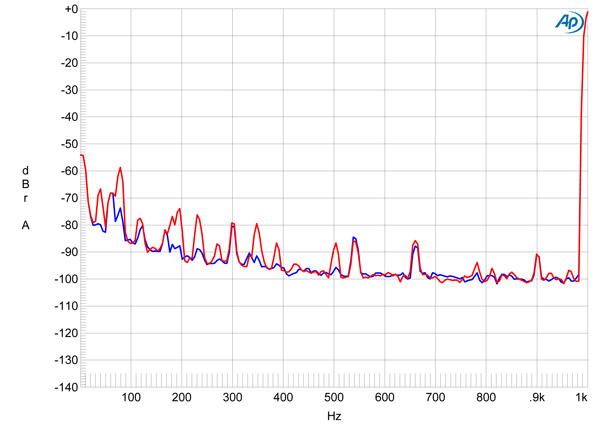
Channel separation was >70dB in both directions across the audioband, though this measurement was affected by the presence of low-frequency random noise (fig.2). The combination of high gain and passive RIAA correction will result in a higher noisefloor than usual. However, the Phono 70's unweighted, wideband S/N ratio, measured with the inputs shorted to ground, was a good 63.6dB in the left channel and 62dB in the right channel, referred to the standard MC input signal of 1kHz at 500µV. Restricting the measurement bandwidth to 22Hz–22kHz increased the ratio to 67dB in both channels, while switching an A-weighting filter into circuit further increased the ratio to 74.5dB.
Paradox doesn't specify overload margins, though Robinson told Mikey that he'd tried cartridges that output up to 450µV without any problems. MF did most of his auditioning with an Ortofon Verismo cartridge, which has a nominal output of 200µV, 8dB below the usual 500µV. The THD+noise in the Phono 70's output with a 1kHz signal reached 1% at 2V output, which is equivalent to an overload margin of 6.5dB referred to 500µV. This is lower than usual, but it does represent an acceptably high margin of 14.5dB ref. the Ortofon's 200µV output. The overload margin at the bottom of the audioband was the same, but at 20kHz it was just 0dB ref. 1kHz at 200µV.
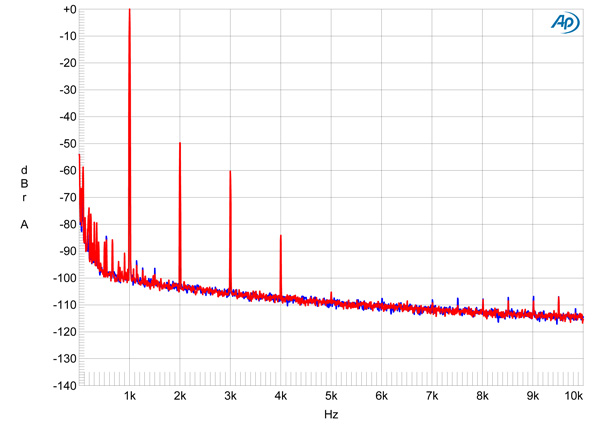
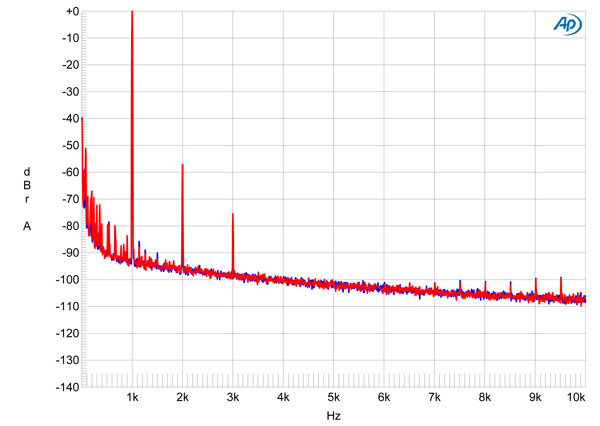
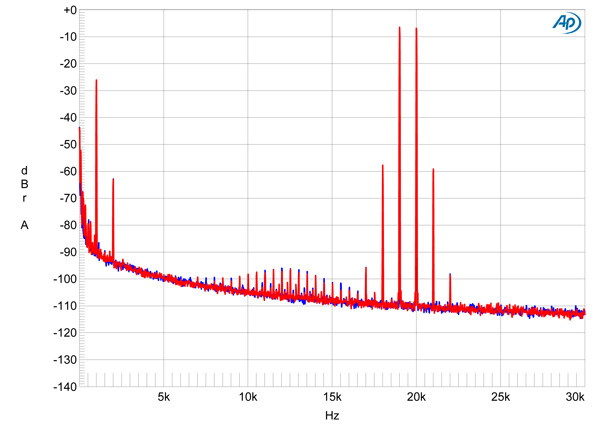
With 1kHz at 500µV, the subjectively innocuous second harmonic was the highest in level, at –50dB (0.3%, fig.3) with the third harmonic 10dB lower. Reducing the input level to 220µV lowered the levels of both harmonics, with the second now lying close to –60dB (0.1%, fig.4). I examined intermodulation distortion with an equal mix of 19kHz and 20kHz tones, at a peak input level equivalent to 1kHz at 200µV. As expected from the poor overload margin at the top of the audioband, the second-order difference product at 1kHz was relatively high in level, at –27dB (4.5%, fig.5).
Its performance on the test bench indicates that the Paradox Phono 70 Signature must be used with low-output moving coil cartridges, the lower the output, the better.—John Atkinson

Too costly for buying on a whim, but right in there for when it will be time for real shopping.

Hi
"Too Costly" ?
From my technical viewpoint, this $3,000 is a killing huge deal ! A rare example of unprofiteering business, consumers' wallent friendly, IMO.
I'm yet to find out which other makes phono-premp(s) in the marketplace today for much much much higher pricing offering quality designs as such:
(1) Costly Audio Note silver titanium resistors, silver foil caps.
(2) print-thru gold plated thick PC board
(3) PASSIVE RIAA EQ.
(4) class A amplication topology
(5 MC input.
"on a whim" ?
Sonics is a personal subject thing. With above such quality designs, $3,000 spending is NOT "a whim" at all, IMO.
Jack L

I said, "Too costly to buy on a whim."
Jesus Christ.
That meant that I could no simply buy one without consideration for cost.
I should have typed slower.
Did you miss..."but right in there for when it will be time for real shopping."
My hand is on my forehead regarding your reply.
Is that so hard to figure out?
You seem to get it at the end of your post, but taking "too costly" out of the sentence context is just silly.

Hi
OK. Write simple English next time then !
"but right in there for when it will be time for real shopping."
I would put it: "Here is the time for real shopping for a phono-preamp !"
Jack L

You internet trolls are amazing.

Hi
Not as "amazing" as your trolling misleading English, pal !
Jack L

I don't think the problem lies with him, pal.

Hi
Not many readers got the whole world's time to read it "several times".
I don't. Who doesn't want to read simple straight-forward Enlgish ?
Jack L

I hope you find your way out from under your troll bridge!

A Star Trek level paradox:
"Sorry for going overboard (about how big companies get reviews because they advertise), but the big magazines will not review my products unless I become an advertiser with them. I have been told this directly."
Is Stereophile not a big magazine? If not, who is?

... you should include MF's response as well: "but I didn't ask you to "pay to play," did I? Which is not to say that some other magazines don't work that way."

Hi
This statement sounds paradoxical, right ?
Mr. Robinson misused the key controversial word "the" instead of the proper word: SOME.
Take it easy, loyal Stereophile patrons !!
Jack L

..but just wanted to give an accolade to this site. You are, IMO, the best reviewer in the industry...always learn something and am always available to read any review you post. Something to be learned each time.

Thank you Mr. Fremer for such a great review.
Terence Robinson